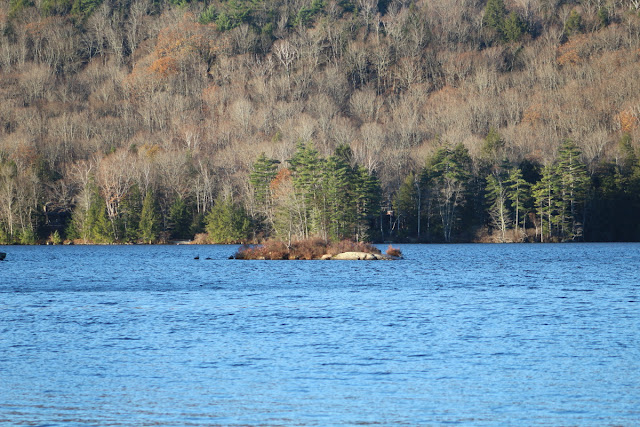I hope everyone had a good Thanksgiving with family and friends and lots of turkey. I kept my eye out for un-cooked turkeys this week, but none were to be found, so here's a picture from November several years ago.
What
was plentiful this week were mergansers, right after I noted last week that I hadn't seen but one pair of mergansers all fall. Now there are hooded and common mergansers, travelling in groups as well as pairs.
 |
| Common Mergansers looking a bit like loons in their fall plumage |
 |
| Mr. and Mrs. Hooded Merganser |
 |
| Mom |
 |
| and Dad |
On one crisp morning I saw a flock of juncos flitting about the small saplings looking for seeds.
 |
| Dark-eyed junco (Junco hyemalis) |
It was my first greeting from these friendly birds this fall. Many live in New Hampshire year-round as the Lakes Region is in their sweet-spot, but they don't seem to be visible much in the summer, perhaps because they are hidden by the foliage as they forage on the forest floor for seeds. Many juncos spend their summers in Canada and come farther south for the winter; it's not clear whether the birds we see in winter are year-round residents, or whether ours move south and are replaced by those from Canada moving here. Regardless, all of them are more exposed with the leaves off the trees and soon they will be as common as chickadees under the feeders.
On those calm, cold mornings, ever-larger coves on the lakes are covered with a skim of ice, and some of them are keeping a little ice even as the day warms, though most of Lake Wicwas is still a bright November-blue.
 |
| Bright water, drab trees |
November offers clear hiking weather, with nice sight lines absent all the leaves, and one of my friends (thanks CM!) inspired me to hike up Fogg Hill in Center Harbor. This is always a nice walk (you can find a
map for the 2-mile round trip walk here) with many signs of moose also using the trail (those wide antlers make it hard to fight through the forest) as shown by so many trees stripped of bark, sometimes up to 12 feet high - those are some big animals!
 |
| Bark stripped off trees along the sides of the Fogg Hill Trail |
The beaver pond along the trail was completely frozen over.
 |
| Beaver pond beside the Fogg Hill trail |
I read in an
article shared by NHLakes that beavers will break through thin ice-skims to prolong their activity a bit longer, but soon they will be restricted to living under a barricade of ice until spring liberates them once again.
 |
| Photo by Kay and Peter Shumway |
How many more sunrises will we get with light reflecting off liquid water before the lakes are sealed off from all of us?











No comments:
Post a Comment